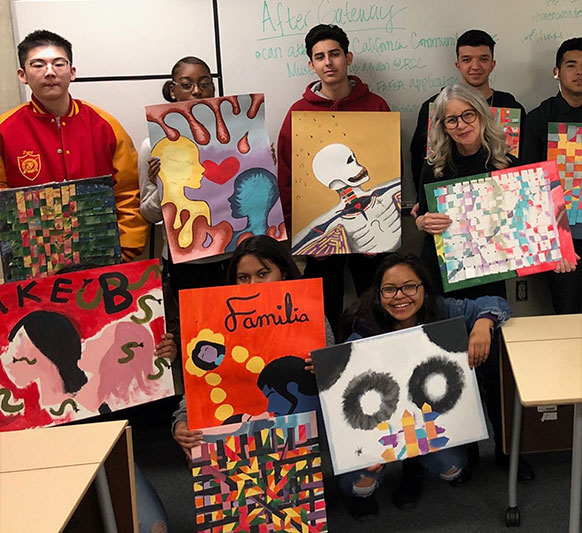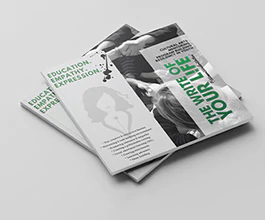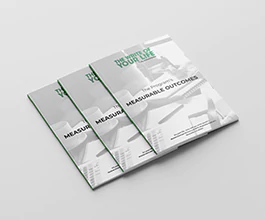
For Parents, Students, and Teachers
Creating Opportunities for
Self-Discovery and Success
The Write of Your L!fe™ engages and mentors students affected by abuse, crime, trauma, victimization, and other hardships and promotes healing and self-expression through the arts.
When students complete The Write of Your L!fe™ program, they exhibit cognitive, affective, and behavioral changes. These changes positively affect the way they treat themselves and their families. Students, parents, or teachers interested in how they can get involved with the program can learn more below.
- 12-week or yearlong program options
- All programs delivered on-site
- Teachers are trained by experienced The Write of Your L!fe™ facilitators

FOR STUDENTS
When you're a participant in The Write of Your L!fe™ program, you'll be guided by trauma-informed instructors and meet weekly with your group to participate in lessons designed to build resiliency, empathy, self-esteem, critical thinking, and more. Through writing and creating art, you'll learn how to communicate effectively and creatively to have more command of your voice. The creation and publication of your work, plus setting and meeting deadlines, will instill the sense of pride and confidence required to fight through adversity.
Are you ready to put the past behind you and write your own story?
Submit Your ApplicationFill out the entrance or exit survey by clicking below.
Take The SurveyCurrent students - upload your vision board, publishable writings, and more by clicking below.
Upload My WorkAre you interested in bringing The Write of Your L!fe™ to your school?
Fill our the form below with information about your school and we and we will get back to you to discuss how we can make it happen!



FOR PARENTS
As a parent, you know the strength of your child better than anyone. By giving your child the opportunity to be part of The Write of Your L!fe™, you’re empowering them to take a path to an even more resilient future. The program uses a social-emotional learning curriculum taught by trauma-trained instructors and art providers. It is typically twelve students to two facilitators, meeting once weekly for two hours.
When it comes to the future of our students and the health and safety of our communities, we’re all part of the village. Parents and guardians are part of the solution, whether that means enrolling your student or bringing a program to your school or community site, starting with the initial enrollment application.
Enroll your student today in a program near you
FOR TEACHERS
Day after day, you see first-hand how trauma affects students in school. It is clear that chronic trauma can cause serious learning problems and behavioral issues, but as an educator who only sees students for eight hours per day, it is particularly hard for you to address.
When students mask their pain with behavior that’s aggressive, off-putting, or in ways that break school rules, they are often punished in ways that can severely affect their educational outcomes. As educators, we can instead equip our students with resources that reinforce resilience and accountability.
Have you seen enough of the school-to-prison pipeline? Contact your administrators today to see if The Write of Your™ L!fe is feasible at your school.
Are you interested in bringing The Write of Your L!fe™ to your school?
Fill our the form below with information about your school and we and we will get back to you to discuss how we can make it happen!



Why The Write of Your L!fe™ Matters
Understanding the School-to-Prison Pipeline
We know youth at risk of trauma and abuse are more likely to struggle in standard academic settings. Yet, these students experiencing hardships are still being disproportionately punished, becoming incarcerated due to these harsh school and municipal policies. This is what’s known as the school-to-prison pipeline, the cascade of effects that occur when children are pushed out of schools and into the juvenile justice system. This pipeline exacerbates existing racial and economic disparities in the education and justice systems.
When traumas affect how a student behaves in school, and teachers, administrators and law enforcement don’t ask “what happened” to the student and their family, they may be left assuming something is just “wrong” with them. This oftentimes leads to prosecutions, suspensions and expulsions, further traumatizing students and exacerbating the school-to-prison pipeline. Recent statistics show that students suspended or expelled for a discretionary violation are three times more likely to be in contact with the juvenile justice system the following year.
Students who experience suspensions or other disciplinary measures in schools are at substantially higher risk of entering the juvenile justice system. The problem grows significantly when compared to racial minorities.
Black students make up 39 percent of all expulsions, even though they only make up 18% of the population
African Americans make up 40% of incarcerated youth
Hispanics make up 20% of incarcerated youth
Chronic absenteeism is a national crisis impacting over 7 million or 1 in 6 students nationally, however students of racial minorities are disproportionately impacted. The national rate of chronic absenteeism is 16%, but racial minorities are chronically absent at much higher rates.
Students who identify as Hispanic experience chronic absenteeism at a rate 7% higher than the national average
Students who identify as Pacific Islander experience chronic absenteeism at a rate 42% higher than the national average
Almost 90% of students with severe attendance problems were low-income
Students who identify as Black experience chronic absenteeism at a rate 30% higher than the national average
Students who identify as American Indian experience chronic absenteeism at a rate 63% higher than the national average
Here’s How The Write of Your L!fe™ Can Help
With social-emotional learning, cultural arts, and restorative justice programs, The Write of Your L!fe™ is here to provide creative alternatives to suspension and expulsion, stopping unnecessary incarceration at its source. We focus on the two primary development goals of the education system for the individual student:
1.
Mentoring
The development of strong and trusting relationships with key adults in the lives of students, particularly those in their school.
2.
Restorative Justice
The formation of positive attitudes towards fairness and justice.
Are you a school administrator interested in bringing The Write of Your L!fe™ to your school?

What educators are saying…
“The students are really enjoying the class and you and Allison are definitely making a difference in their lives. Everyone at the site is noticing a change in them. Thank you so much for everything.”
Chelsea Schweer
Innovation High School TutorWhat educators are saying…
"I noticed the girls are truly invested in your program, we observed all the support you provide for them and think it’s tremendous."
Michele Worth
Visual Arts InstructorWhat educators are saying…
"I'm really proud of the work the students produced this semester in The Write of Your L!fe."
Scott Jacobs
Instructor of Expository Reading and Writing, Gateway College and Career AcademyWhat educators are saying…
"I see almost everything with a positive outlook. I can express myself more than I did before."
Daisy
Gateway to College, Riverside City College Freshman

